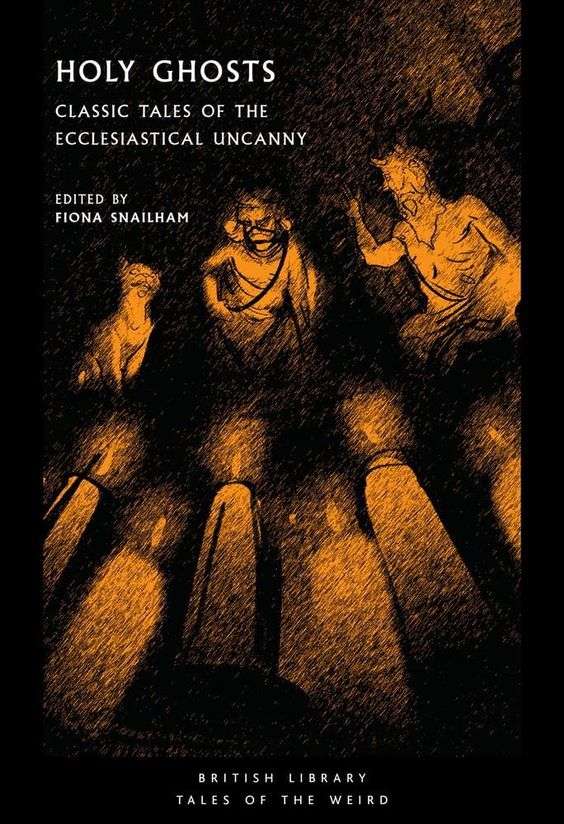HOLY GHOSTS: Classic Tales of the Ecclesiastical Uncanny edited by Fiona Snailham
British Library Tales of the Weird p/b £9.99
Reviewed by Nigel Robert Wilson

This collection of short stories about the supernatural edited by Fiona Snailham is mistitled. The subtitle is more appropriate. Entities traditionally described as ghosts rarely appear in these tales, whereas the dire consequences of misplaced piety, guilt and theological condemnation are arrayed in all their magnificence. If the reader seeks the thrills of horror, then these stories collected largely from nineteenth-century writers will generate a suitable gallery of frissons.
Each story is conveniently dated, allowing the reader to observe the development of literary styles with a short introductory statement as to the author and their other work.
The longest tale is `The Poor Clare’ by Elizabeth Gaskell. In itself, this tale, based in the mid-eighteenth century, is a historically cultural document. Central to its theme is the unpleasant trope fashionable in the romantic period that individuals deemed as Celtic, as opposed to being the rational English, were naturally disorderly and chaotic people. The narrative begins with an ancient home fallen upon bad times containing a lonely occupant. The story revolves around an angry curse invoked against an arrogant man who was not known to be married to the daughter of the woman who formed the spell. This had the effect of forcing an evil double to possess her own granddaughter. The denouement is found in a fatal yet heroic redemption at a time of great stress to the wider community.
This places the opening tale `The Sexton’s Adventure’ by Sheridan Le Fanu at a disadvantage despite it being an excellent instruction in the evils of the demon alcoholic liquor; a lesson `The Parson’s Oath’ by Mrs Henry Wood might reflect on given the disappearance of the unfortunate Miss Winter until her ghost is perceived inhabiting the former garden of her murderer the emigrant Brassy Brown whom she had rejected as a suitor.
`A Story Told in Church’ by Ada Buisson is more about a callous murder than anything supernatural. It does, however, illustrate that human jealousy is a far more malicious emotion than fear. The phenomenon of murderous jealousy is further explored in `In the Confessional’ by Amelia B Edwards, which is derived from the time when Victorian British tourists began to discover the Rhineland.
By far, the best tale in the collection is `Man-Size in Marble’ by E. Nesbitt. Here, the reader finds themselves shouting at the narrator to return home to protect his beloved from a supernatural manifestation he had been warned about. Instead, he chooses to explore the other end of this weird occurrence, requiring him to face a tragic outcome.
`The Face of the Monk’ by Robert Hichens is an exquisite tale of human redemption. A morally relaxed individual encounters a clairvoyant who warns him his guardian angel condemns him. Then, in due time, our hero finds himself in an Alpine monastery, confronting his own angel who begs him to redeem himself. Of course, he fails, but in his remorse, he tries to commit suicide. This means he is confined to a lunatic asylum where he finds the peace and contentment he needs.
`An Evicted Spirit’ by Marguerite Merrington is more a social observation than a tale of what happens after a person dies. `The Cathedral Crypt’, an early story by John Wyndham is about an immolation in a Spanish cathedral of a young nun who has betrayed her vows. This is a feeble tale interestingly written immediately before the start of the Spanish Civil War.
`The Duchess at Prayer’ by Edith Wharton involves a statue that changed its face following the murder of its subject by her husband. Their difficult relationship lay in a total mismatch of personalities: he was an intellectual, and she a beautiful, sensuous woman. There is a distinct whiff of black magic in this tale.
Of course, `The Stalls of Barchester Cathedral’ by M R James is a significant factor in this collection. This well-known tale of the transformative nature of the archdeacon’s stall in the cathedral and the cat that haunts his staircase is a classic. The idea, however, of a faerie tree on which the ignorant peasants hang their hopes and dreams would never, ever be the same place used for executions. The contempt the ruling class holds for the humble often offends.
